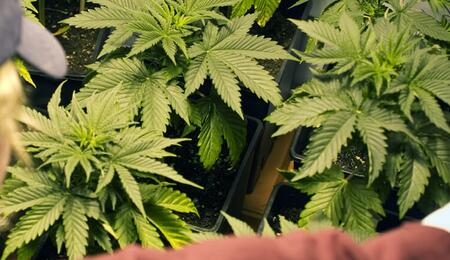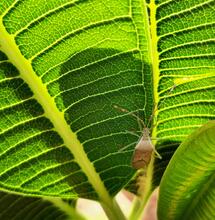Mobile and Immobile Nutrients

The majority of nutrient deficiencies and excesses can be avoided by keeping a few simple environmental factors in check including air circulation, ventilation, temperature and humidity. Plants will also need adequate light, living organic soil or clean substrate, clean water and regular maintenance, clean up. Letting these environmental factors get out of control will open the door to nutrient problems. This short article will concentrate on the most basic nutrient availability and excesses. It will also include simple troubleshooting techniques and solutions.
Most any nutrient formula (fertilizer), regardless of its contents, will grow cannabis. But what quality will the cannabis be, and what are the residual health concerns? With the proper nutrient formula and growing conditions, medical cannabis can reach its genetic growth potential.
Nutrients
Cannabis needs the non-mineral nutrients carbon, hydrogen, and oxygen to manufacture food and grow. Carbon (CO2) in the air is fixed via photosynthesis. Hydrogen atoms that are building blocks come almost totally from water. Oxygen from the atmosphere is used in respiration and plant processes. The rest of the elements (called mineral nutrients), are absorbed from the growing medium and nutrient solution. Supplemental nutrients supplied in the form of a fertilizer help medicinal cannabis to reach its maximum potential.
Nutrients must be available to roots in order to be absorbed. Nutrients occur in many chemical combinations and forms (called compounds) that are comprised of two or more nutrients’ ions joined together via positive (anion) and negative (cation) attractions. The compounds release nutrients for uptake by roots under specific conditions. The proper nutrient formula delivered at the proper pH and EC concentration makes nutrients available for uptake. An anion is an ion with a negative charge because it has more electrons than protons.
A cation is an ion with a positive charge because it has more protons than electrons. Well-managed life—microbes, bacteria, fungi, etc.—in organic soil interacts with naturally occurring nutrients to make them available for uptake by roots. Properly mixed and alimented soils with high fertility require very little supplemental fertilizer.
For example, during the flowering stage, outdoor gardeners in Humboldt County, California, add just 2 handfuls of bat guano to grow 10-pound (4.5 kg) plants in living organic soil. Here is a fun fact. Home gardeners caring for lawns, flowers and vegetables apply 10 times more fertilizer than farmers growing food crops. I believe that cannabis gardeners apply up to 20 times more fertilizer than needed. The excess fertilizer washes into the sewer or ground water further complicating availability of other nutrients.
Or, in the case of sewer water, excess mineral nutrients creates toxic residuals that are harmful to the environment. Nutrients are grouped into 3 categories: macronutrients or primary nutrients, secondary nutrients, and micronutrients or trace elements. Each nutrient in these categories can be further classified as either mobile or immobile.
Solving nutrient-deficiency problems is much easier when you know which nutrients are mobile or immobile. Experts have a difficult time agreeing on terms. Some confusion exists on what the secondary nutrients are, but they are generally considered macronutrients as well as secondary macronutrients, and are measured the same way as a percentage of the overall mix. On the other hand, trace elements are micronutrients and measured in parts per million (ppm).
Mobile nutrients are able to move (translocate) from one part of the plant to another as needed. When a nutrient shortage occurs, mobile nutrients travel to the area to solve the deficiency. For example, nitrogen accumulated in older leaves translocates to younger leaves to solve a deficiency.
Mobile nutrients show deficiency symptoms on older, lower leaves first. Nitrogen will show a deficiency on older leaves because it is a part of essential enzyme structure and has to be replaced as these enzymes are denatured and disposed of. Mobile nutrients include nitrogen (N), phosphorus (P), potassium (K), and magnesium (Mg). Immobile nutrients either stay at their destination or move very little once assimilated and transported.
Immobile nutrients include calcium (Ca), boron (B), chlorine (Cl), cobalt (Co), copper (Cu), iron (Fe), manganese (Mn), molybdenum (Mo), silicon (Si), sulfur (S) and zinc (Zn). Deficiencies of immobile nutrients show symptoms first in younger leaves. These nutrients do not translocate to new growing areas as needed. They remain deposited in their original place in older leaves. Other elements—Barium (Ba), Cadmium (Cd), Chromium (Cr), Lithium (Li), Palladium (Pd), and Vanadium (V)—may be necessary for plant growth and health. These elements should be available in low concentrations.
Toxic Nutrient Conditions
Too often gardeners give their medical cannabis gardens too much tender loving care. This care and enthusiasm is kindled by countless nutrient and additive advertisements. As a consequence, medical cannabis gardeners frequently over-apply fertilizers and additives, creating toxic soil conditions. Often the solution to this problem is to leach the built-up nutrients out of the growing medium with copious quantities of water. This will wash away excess nutrients that have built up in the soil and created toxic conditions.
An overabundance of nutrients (fertilizer salts) in the growing medium disrupts the medium’s chemical balance. This imbalance causes some nutrients to become unavailable for uptake by roots and other nutrients to be oversupplied. Leaching the substrate works well for most nutrient problems, but it does not solve all nutrient problems. For more information, please learn more about specific nutrients.
Leaching Growing Mediums
To leach soil or substrate, add enough water, remember, it takes a lot of water, to the medium to wash out excess fertilizer (nutrient) salts. For a container that holds 3 liters of water, add enough water to make sure it is full—until water drips out the bottom. Then apply 3 additional liters of water and allow 3 liters to drain out the bottom of the container.
Do this a total of 7 times. Once a total of 21 liters of water has been added and drained, the process is almost complete. Add 3 more liters of water that includes the correct ratio and concentration of fertilizer. The entire process must be completed within 20 minutes or the excess of water will drown the roots.
The process can be done 2 or 20 times, as long as it is completed within 20 minutes. I repeat: the container must drain completely within 20 minutes. “Drain completely” means drain to a point at which the water is held against gravity within 20 minutes. This practice is not overwatering. *Water is used to leach fertilizer salts from a growing medium.
Just before harvest, plants and soil are flushed to remove excess nutrients in plant tissue. Note: See chapter 9, Harvest, Drying & Curing, for more info about leaching the substrate and flushing nutrients out of medical cannabis plants before harvest. See chapter 23, Container Culture & Hydroponics, for more information on leaching hydroponic mediums and water-based hydroponics.
Jorge Cervantes is author of the Cannabis Encyclopedia (596 pages, 2,000+ color images, large A4 format) and Marijuana Horticulture (AKA the Bible). Booth books are available at all amazon retailers worldwide. Both books have excellent chapters on nutrients. Contact Jorge at www.marijuanagrowing.com.
By Jorge Cervantes jorge@marijuanagrowing.com



.png)